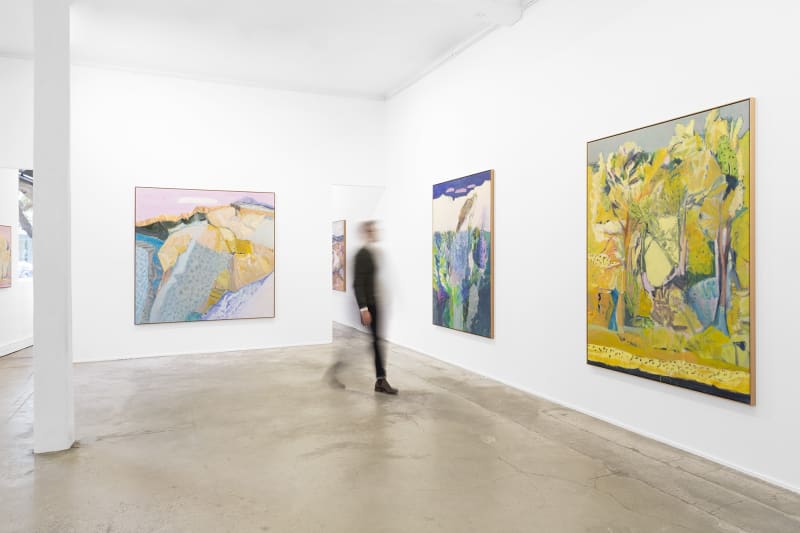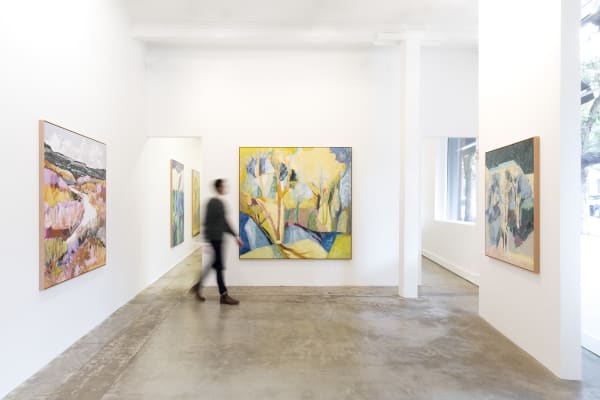Jo Bertini: Land of Shining Stone
-
 Jo BertiniBetween Places, 2019oil on Belgian linen152 x 152 cm, 155 x 155 cm (framed)
Jo BertiniBetween Places, 2019oil on Belgian linen152 x 152 cm, 155 x 155 cm (framed) -
 Jo BertiniBroken Mesa, 2019oil on Belgian linen96.5 x 91.5 cm, 99.5 x 94.5 cm (framed)
Jo BertiniBroken Mesa, 2019oil on Belgian linen96.5 x 91.5 cm, 99.5 x 94.5 cm (framed) -
 Jo BertiniBrother Moon, Sister Sun, 2019oil on French polyester canvas127 x 127 cm, 130 x 130 cm (framed)
Jo BertiniBrother Moon, Sister Sun, 2019oil on French polyester canvas127 x 127 cm, 130 x 130 cm (framed) -
 Jo BertiniCactus Country, 2019oil on French polyester canvas152 x 152 cm, 155 x 155 cm (framed)
Jo BertiniCactus Country, 2019oil on French polyester canvas152 x 152 cm, 155 x 155 cm (framed) -
 Jo BertiniChokecherry & Cottonwoods in Fall, 2019oil on French polyester canvas163 x 129.5 cm, 166 x 132.5 cm (framed)
Jo BertiniChokecherry & Cottonwoods in Fall, 2019oil on French polyester canvas163 x 129.5 cm, 166 x 132.5 cm (framed) -
 Jo BertiniCholla Land, 2019oil on French polyester canvas91.5 x 86.5 cm, 94.5 x 89.5 cm (framed)
Jo BertiniCholla Land, 2019oil on French polyester canvas91.5 x 86.5 cm, 94.5 x 89.5 cm (framed) -
 Jo BertiniDesert Garden in the Land of Enchantment, 2019oil on French polyester canvas152.5 x 152 cm, 155.5 x 155 cm (framed)
Jo BertiniDesert Garden in the Land of Enchantment, 2019oil on French polyester canvas152.5 x 152 cm, 155.5 x 155 cm (framed) -
 Jo BertiniDream Hunting, 2019oil on Belgian linen96.5 x 121.5 cm, 99.5 x 124.5 cm (framed)
Jo BertiniDream Hunting, 2019oil on Belgian linen96.5 x 121.5 cm, 99.5 x 124.5 cm (framed) -
 Jo BertiniForgotten Places, 2019oil on Belgian linen96.5 x 172.5 cm, 99.5 x 175.5 cm (framed)
Jo BertiniForgotten Places, 2019oil on Belgian linen96.5 x 172.5 cm, 99.5 x 175.5 cm (framed) -
 Jo BertiniJoshua Tree, 2019oil on French polyester canvas91.5 x 86.5 cm, 94.5 x 89.5 cm (framed)
Jo BertiniJoshua Tree, 2019oil on French polyester canvas91.5 x 86.5 cm, 94.5 x 89.5 cm (framed) -
 Jo BertiniPiedra Lumbre – Land of Shining Stone, 2019oil on French polyester canvas199 x 199.5 cm, 202 x 202.5 cm (framed)
Jo BertiniPiedra Lumbre – Land of Shining Stone, 2019oil on French polyester canvas199 x 199.5 cm, 202 x 202.5 cm (framed) -
 Jo BertiniRainbird Country (Red Tailed Hawk), 2019oil on Belgian linen199.5 x 147.5 cm, 202.5 x 150.5 cm (framed)
Jo BertiniRainbird Country (Red Tailed Hawk), 2019oil on Belgian linen199.5 x 147.5 cm, 202.5 x 150.5 cm (framed) -
 Jo BertiniRiver of Stars, 2019oil on Belgian linen152.5 x 152 cm, 155.5 x 155 cm (framed)
Jo BertiniRiver of Stars, 2019oil on Belgian linen152.5 x 152 cm, 155.5 x 155 cm (framed) -
 Jo BertiniShadow Shifter on a Bitter Lake, 2019oil on Belgian linen96 x 173 cm
Jo BertiniShadow Shifter on a Bitter Lake, 2019oil on Belgian linen96 x 173 cm -
 Jo BertiniStone Mother, 2019oil on Belgian linen121.5 x 162.5 cm, 124.5 x 165.5 cm (framed)
Jo BertiniStone Mother, 2019oil on Belgian linen121.5 x 162.5 cm, 124.5 x 165.5 cm (framed) -
 Jo BertiniTalking to the Ground, 2019oil on French polyester canvas151 x 121.5 cm, 154 x 124.5 cm (framed)
Jo BertiniTalking to the Ground, 2019oil on French polyester canvas151 x 121.5 cm, 154 x 124.5 cm (framed) -
 Jo BertiniThe Finding Moon, 2019oil on Belgian linen122 x 151 cm, 125 x 154 cm (framed)
Jo BertiniThe Finding Moon, 2019oil on Belgian linen122 x 151 cm, 125 x 154 cm (framed) -
 Jo BertiniThe Longing Place, 2019oil on Belgian linen203 x 149 cm, 206 x 151 cm (framed)
Jo BertiniThe Longing Place, 2019oil on Belgian linen203 x 149 cm, 206 x 151 cm (framed) -
 Jo BertiniThe Trackless Wild, 2019oil on French polyester canvas122 x 122 cm, 125 x 125 cm (framed)
Jo BertiniThe Trackless Wild, 2019oil on French polyester canvas122 x 122 cm, 125 x 125 cm (framed) -
 Jo BertiniWildwood, 2019oil on French polyester canvas199 x 199 cm, 202 x 202 cm (framed)
Jo BertiniWildwood, 2019oil on French polyester canvas199 x 199 cm, 202 x 202 cm (framed)
The very idea of a desert evokes a camel-string of clichés: shimmering mirages, trackless wastes and blinding dust storms, dwindling water supplies and hopeless odds. Implacable and untamed, deserts have tested the will and endurance of explorers and prophets over the centuries. Their accounts have fixed the desert as a site of banishment and tribulation but also as a mysterious source of purity and renewal. That quality is evident enough if one has the fortune to experience a torrential thunderstorm sweep across a desert’s baking surface, filling claypans within minutes and turning dry rivulets into streams. Deserts are transformed into gardens, suddenly fueling all the life their aridity had suppressed. A detailed understanding of that cycle of death and renewal has underpinned the secular and sacred existence of desert-dwellers in Africa, Australia, the Americas and Asia for many thousands of years, well before European explorers began their single-minded transects. The first ‘desert art’ emerged from that comprehension, as pictographs or marks on desert rock-shelters or as song poetry embedded in oral traditions.
Jo Bertini is well aware of those deep traditions, but her art is of another kind. Defining it is not so easy. Deserts are intriguing and challenging subjects for the artist. The initial attraction might rest in their apparent simplicity, spare forms and unimpeded vistas – in other words, in the opportunity to reduce complexity and to render nature and topography in the simplest terms. For such artists deserts are principally metaphorical, best left uncluttered by detail; the result often reflects the standard European perceptions of such places – austere, alien, reductive and polarizing. Jo Bertini’s desert landscapes offer an alternative view, richer and more nuanced. In this respect it is fascinating to see her ‘Land of Shining Stone’ series within the context of her earlier work in Australian deserts.
Jo’s early work seems devoted to an understanding of the relationship between light, colour and topography in the desert. Those paintings reveal her engagement with the idea that the desert’s own composition is necessarily fluid and changeable. A slight shift in angle and perspective may cause an ancient watercourse to emerge, or a barely visible dune to rise up and exert its effect through the rich red of its flank or the shadow it casts. For this artist the desert was never a static place, even apart from the life it allows to exist, so cryptically. Jo’s Australian paintings are full of poetic contingency, their shifting topographies aligning and realigning with variations in the desert’s colour, light and mood.
Now, in the New Mexican landscape, Jo Bertini has made beautiful sense of a desert with an entirely different character but the same harsh and enduring core. Making sense of a desert does not mean revealing a vista or path through its topography. It is more about engaging with colour and light to reveal the desert’s complexity, without a single cause or effect - where the most fragile plant seems secure and where a hawk casts its imperious gaze at the passing traveller. Such figures of animals and plants were almost absent from her Australian works, where her artistic energy was directed towards the challenge of conveying the desert’s topography, the composition of its forms. Here in New Mexico one has the sense that she has met that challenge and that her insights into the desert are broader, deeper and richer. Her desert explorations have entered a new, exciting phase.
Dr Philip Jones
Art Historian & Senior Curator, South Australian Museum
Research Fellow Harvard University, Cambridge, Massachusetts, USA
Individual Fellow, NIAS, Royal Netherlands Academy of Arts & Science, Amsterdam

























